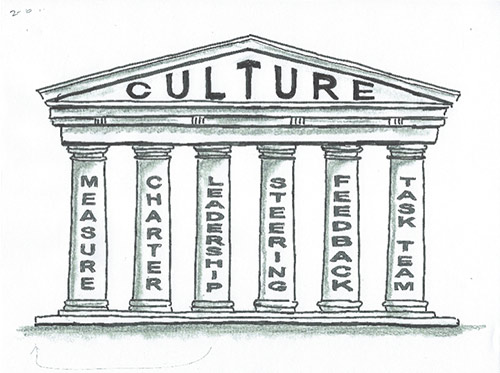Sort Articles:
The Pillars of Organizational Culture
Written by: Ralph Twombly
Published: Tue Dec 07 2021 13:59:20 GMT-0500 (Eastern Standard Time)
A successful man is one who can lay a firm foundation with the bricks others have thrown at him.
David Brinkley
What People Need
In a previous book, I shared my view that people’s motivations are predictable. First, we all want to be included when we can be included. And then, we want to be appreciated for our hard work, bright minds, and good souls. Culturally, there are just a few addons to consider:
- People want permanence. They are not looking to sign long-term contracts or receive promises that cannot be fulfilled. They want to know that their jobs will be there tomorrow as long as they give more than they receive.
- People want to feel that their work has significance and that they might leave a legacy. If you can find a way organizationally to provide these tasty morsels of motivation to people’s lives, they will do incredible things for your organization.
- Finally, people have this gnawing need to learn and to keep learning. We have been doing this as humans long before organizations were formed and even before we had the language to express in writing what we were learning.
 Now, if you are reading this and thinking of your one or two “crazy employees” who want, want, want, I will ask you to suspend the thought for a while. We will return a little later to your “crazy employees.” In truth, many organizations don’t think that these motivators are real and, even if they did, they wouldn’t know how to satisfy them.
Now, if you are reading this and thinking of your one or two “crazy employees” who want, want, want, I will ask you to suspend the thought for a while. We will return a little later to your “crazy employees.” In truth, many organizations don’t think that these motivators are real and, even if they did, they wouldn’t know how to satisfy them.
Cultural initiatives restart the organization much like my weird computer that works along nicely until it starts to get a mind of its own and then I simply reboot. Presto, it usually works. But you cannot simply reboot an organization. Instead, you need to redo much of what has created the problem including leadership, decision-making, innovation, and formal and informal systems.
Here is a good place to start the conversation of what to do. And, like any complicated thing, cultural work has a methodology. You wouldn’t try to fix your car without some experience, tools, training, and a manual. Culture needs to be thought of like fixing your car or building a home. It would be nice when you buy a piece of land to simply move the family to that space and allow it to take shape around you. Come winter, you may find that you should have thought it through more carefully. Here is the good news – it is the people who build and rebuild culture if they are given the right direction and tools.
I lost track long ago of the number of times people have come to me alluding to or speaking directly about how difficult people are in their environment, on their team, or how difficult their boss is or was. As leaders we struggle to confront bad behavior, praise good behavior, and lack the understanding of how and why people behave as they do. We struggle to understand our kids and friends, those politicians, and people from away. It’s funny and ironic that we that we are one species and others are trying to understand us, too.
Building on Sand
One of the most difficult cultural efforts was an unnamed service organization that wanted to build their organization’s culture so they would be a more attractive acquisition target. They didn’t tell anyone of the intent, including us, and poured all their efforts, money and time into the initiative expected. For over two years, we created this nimble organization that brought all the best ideas to the surface, retrained leaders, and developed employees. We met, we trained, we built a cultural steering process, and we got support and leadership at the highest levels. We made real progress and built a strong momentum.
Before we started, they were struggling with innovation, heavy-handed leaders, a shrinking market, and their growth in past years left a large communication gap that had not been addressed. As the initiative moved forward, they issued business cards to their blue-collar workforce in the interest of allowing them to feel like owners in the business. This and other things created a feeling of ownership from their people, and they grew the organization in a very depressed market. People started to feel like they could speak to their leaders and the stories started to come in about the efforts they were giving in their community.
I heard stories like Harry, the technician, who, when arriving at a person’s home, found out that the person was not a regular customer and didn’t know what to do to get a service technician to look at his problem. Out of desperation, the person called and lied, saying he was, in fact, a customer. Previously, Harry would have been authorized to simply pack up and come back to the shop. He stayed, fixed the problem, and when he arrived back at work, he explained to the boss that he wanted the boss to pull the price of the visit from his pay. After some thought, Harry’s boss smiled, and they wrote the whole thing off as being a good servant in their community. These were the stories and the organization they had created. People lined up to work for them, they were making inroads to their market, and they were building trust at each level every day.
One fall day, I got a call from one of owners who told me that they had sold the business to a bigger organization, but “Don’t worry,” he told me, “I told them that we had agreed to honor your agreement until the end of the year and, all the employees benefits and pay will be frozen and they will keep everything like it is and grow the organization.”
As the title of this little story, ‘Building on Sand,’ implies none of the promises were honored. In defense of the original owners, they didn’t know and were duped by people who were clever and never really intended to embrace the values of the original deal. The buyer of this organization wanted the acquisition because of the magic that was created. What they wanted and received were enlightened leaders, engaged employees, and a community focused organization that was both innovative and nimble.
In the end, the organization was rebuilt in the model of the “bigger” company and answering the phone at our place became a therapeutic exercise. We were a vendor who built something that employees and leaders alike thought would last forever. We were building on sand. Employees felt betrayed, and because of our influence, I bet many thought we had betrayed them. At the time of this writing, the organization has been sold again and it is looking like maybe the new owners will try to return a bit to what made it the organization that others wanted to buy.
Building on a Foundation of People
 There are six pillars in cultural work that hold it all together and each pillar is related to one or more things that feed human motivation. These pillars don’t cost money and will either work or fade. If you take care of your people, they will take care the customers.
There are six pillars in cultural work that hold it all together and each pillar is related to one or more things that feed human motivation. These pillars don’t cost money and will either work or fade. If you take care of your people, they will take care the customers.
- Pillar one – Initiate and be responsible for a periodic measurement of existing and preferred culture.
- Pillar two – Have your people build a charter annually that creates proactive behavior for the year ahead.
- Pillar three – Put in place leadership that supports the culture – air-tight, people focused, bullet proof, and always growing.
- Pillar four – Commit to a continual, rotating steering team made of diverse representatives of people in the organization.
- Pillar five – Give and receive feedback and input from all the people in the organization monthly.
- Pillar six – Create highly accountable and a nimble task team to lead the change.
From time-to-time a past cultural client will call as they are feeling some slippage. My first (always free) advice is to hold themselves up against the pillars that we put into place to see where the slippage might be coming from.
What follows are sections dedicated to each pillar. This will be direction on how to build them and hold them. I will share stories of success and a few failures. Each section can be used as a bit of a ‘how to’ manual and should get you started. I will also share a warning that each culture is as different as the fingerprints of its people, but like people, it shares DNA. If you are hungry to know people and create environments where they thrive and will outperform competitors while feeling like a community, welcome in.
Before I head into the First Pillar… a Few Cautionary Notes.
People are different. Pushing people to your standards or qualities will only alienate them. Each of us has a value set. Our actions, attitudes, and behaviors are extensions of those values. One of the main reasons why leaders fail is that they push when they should pull. To push means that you know the way and others must follow. This is the “Get on board, do it my way, because my way is the only way” approach. The by-product of push is that people feel demeaned. If people are pushed hard enough, they dumb-down to avoid the conflict with the boss and you will never get their best.
An alternative is to move on to a place that honors people’s minds as well as the skill that they bring. This is pull. Pull, which is the opposite of push, is attraction. We follow people who believe what we believe and then we will do more than asked. We understand the leader, whom we now learn to believe in and trust. We feel validated by following their lead. People go because they want to, and they only want to when their best interests and values are satisfied. It takes a little training for leaders to get the hang of cultural work and learning about pull is an important piece of the work ahead.
Organizations that focus on one initiative, then go on to the next idea, book, fad, or guru slogan need to avoid cultural work. If there’s a model that works for the top leader in the organization and that leader wants it to be his or her way, then I salute you. Any businessperson worth his or her salt knows when business is working or not and should exercise their leadership prerogative.
Cultural work is designed to build strong teams, a nimble business, allow innovation, and create sustainability. It is not just a change initiative; it is change working every day. People in culturally rich organizations don’t respond to change. They initiate change before it is forced upon them and ask for nothing more than the feeling that every successful entrepreneur knows, ownership.
See you in January and we will get started!
Ralph Twombly
In the 20 years since starting Priority Learning, Ralph has facilitated countless learning experiences and has conducted training for thousands of managers and leaders. With over 30 years of leadership development and organizational development background and work, Ralph continues to build relationships with client companies all over the U.S.

